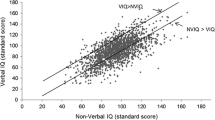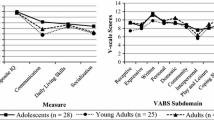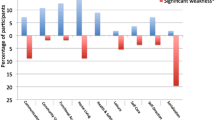Abstract
Research on Autism Spectrum Disorder (ASD) is thriving; however, scant empirical research has investigated how ASD manifests in high ability youth. Further research is necessary to accurately differentiate high ability students with ASD from those without the disorder, and thus decrease the risk of misdiagnosis. The purpose of the present study is to provide an empirical account of the intellectual, adaptive, and psychosocial functioning of high ability youth with and without ASD utilizing a group study design. Forty youth with high cognitive ability and ASD and a control group of 41 youth with high cognitive ability and no psychological diagnosis were included in the study. In comparison to the control group, the ASD group showed poorer functioning on measures of processing speed, adaptive skills, and broad psychological functioning, as perceived by parents and teachers. These findings have significant implications for diagnosing ASD among those with high ability, and the development of related psychological and educational interventions to address talent domains and areas of concern.



Similar content being viewed by others
References
American Psychiatric Association. (2000). Diagnostic and statistical manual of mental disorders (4th ed., text rev.). Washington, DC: American Psychiatric Association.
American Psychiatric Association. (2013). Diagnostic and statistical manual of mental disorders (5th ed.). Washington, DC: American Psychiatric Association.
Assouline, S. G., Foley Nicpon, M., & Doobay, A. F. (2009). Profoundly gifted girls and Autism Spectrum Disorder: A psychometric case study comparison. Gifted Child Quarterly, 53(2), 89–106.
Barnhill, G., Hagiwara, T., Myles, B. S., Simpson, R. L., Brick, M. L., & Griswold, D. E. (2000). Parent, teacher, and self-report of problem and adaptive behaviors in children and adolescents with Asperger Syndrome. Diagnostique, 25, 147–167.
Baum, S. M., Cooper, C. R., & Neu, T. W. (2001). Dual differentiation: An approach for meeting the curricular needs of gifted students with learning disabilities. Psychology in the Schools, 38, 477–490.
Bölte, S., & Poustka, F. (2002). The relation between general cognitive level and adaptive behavior domains in individuals with autism with and without co-morbid mental retardation. Child Psychiatry and Human Development, 33, 165–172.
Bölte, S., & Poutska, F. (2004). Comparing the intelligence profiles of savant and nonsavant individuals with Autistic Disorder. Intelligence, 32, 121–131.
Calhoun, S. L., & Mayes, S. D. (2005). Processing speed in children with clinical disorders. Psychology in the Schools, 42, 333–342.
Carter, A. S., Volkmar, F. R., Sparrow, S. S., Wang, J–. J., Lord, C., Dawson, G., et al. (1998). The Vineland Adaptive Behavior Scales: Supplementary norms for individuals with autism. Journal of Autism and Developmental Disorders, 28, 287–302.
Cederlund, M., & Gillberg, C. (2004). One hundred males with Asperger Syndrome: A clinical study of background and associated factors. Developmental Medicine and Child Neurology, 46, 652–660.
Corbett, B. A., & Constantine, L. J. (2006). Autism and attention deficit hyperactivity disorder: Assessing attention and response control with the integrated visual and auditory continuous performance test. Child Neuropsychology, 12, 335–348.
Corbett, B., Constantine, L., Hendren, R., Rocke, D., & Ozonoff, S. (2009). Examining executive functioning in children with autism spectrum disorder, attention deficit hyperactivity disorder and typical development. Psychiatry Research, 166, 210–222.
Foley Nicpon, M., Assouline, S., & Stinson, R. (2012). Cognitive and academic distinctions between gifted students with autism and Asperger Syndrome. Gifted Child Quarterly, 56, 77–89.
Foley Nicpon, M., Doobay, A., & Assouline, S. G. (2010). Parent, teacher, and self perceptions of psychosocial functioning in intellectually gifted children and adolescents with Autism Spectrum Disorder. Journal of Autism and Developmental Disabilities, 40(8), 1028–1038.
Fombonne, E. (2005). Epidemiological studies of pervasive developmental disorders. In F. R. Volkmar, R. Paul, A. Klin, & D. Cohen (Eds.), Handbook of autism and pervasive developmental disorders (3rd ed., pp. 42–69). Hoboken, NJ: Wiley.
Gallagher, S. A., & Gallagher, J. J. (2002). Giftedness and Asperger Syndrome: A new agenda for education. Understanding our Gifted, 14, 7–14.
Geurts, H. M., Verte, S., Oosterlaan, J., Roeyers, H., & Sergeant, J. A. (2004). How specific are executive functioning deficits in attention deficit hyperactivity disorder and autism? Journal of Child Psychology, 45, 836–854.
Ghaziuddin, M., & Butler, E. (2002). Clumsiness in autism and Asperger Syndrome: a further report. Journal of Intellectual Disability Research, 42, 43–48.
Gilchrist, A., Green, J., Cox, A., Burton, D., Rutter, M., & Le Couteur, A. (2001). Development and current functioning in adolescents with Asperger Syndrome: A comparative study. Journal of Child Psychology and Psychiatry, 42, 227–240.
Goldberg, M. C., Mostofsky, S. H., Cutting, L. E., Mahone, E. M., Astor, B. C., Denckla, M. B., et al. (2005). Subtle executive impairment in children with autism and children with ADHD. Journal of Autism and Developmental Disorders, 35, 279–293.
Gross, M. (2002). Social and emotional issues for exceptionally intellectually gifted students. In M. Neihart, S. M. Reis, N. M. Robinson, & S. M. Moon (Eds.), The social and emotional development of gifted children: What do we know? (pp. 19–29). Waco, TX: Prufrock Press Inc.
Howlin, P., & Asgharian, A. (1999). The diagnosis of autism and Asperger Syndrome: findings from a survey of 110 families. Developmental Medicine and Child Neurology, 41, 834–839.
Huber, D. H. (2007). Clinical presentation of Autism Spectrum Disorders in intellectually gifted students. Unpublished doctoral dissertation, The University of Iowa, Iowa City.
Kanner, L. (1942). Autistic disturbances of affective contact. Nervous Child, 2, 217–250.
Klin, A., Saulnier, D., Sparrow, S. S., Cicchetti, D. V., Volkmar, F. R., & Lord, C. (2007). Social and communication abilities and disabilities in higher functioning individuals with Autism Spectrum Disorders: The Vineland and the ADOS. Journal of Autism and Developmental Disorders, 37, 748–759.
Klin, A., Volkmar, F. R., & Sparrow, S. S. (2000). Asperger syndrome. New York: The Guilford Press.
Klin, A., Volkmar, F. R., Sparrow, S. S., Cichettie, D. V., & Rourke, B. P. (1995). Validity and neuropsychological characterization of Asperger Syndrome: Convergence with nonverbal learning disabilities syndrome. Journal of Child Psychology and Psychiatry, 36, 1127–1140.
Kranzler, J. H., Whang, P. A., & Jensen, A. R. (1994). Task complexity and the speed and efficiency of elemental informational processing: Another look at the nature of intellectual giftedness. Contemporary Educational Psychology, 19, 447–459.
Landa, R. J., & Goldberg, M. C. (2005). Language, social, and executive functions in high functioning autism: A continuum of performance. Journal of Autism and Developmental Disorders, 35, 557–573.
Lehman, E. B., & Erdwins, C. J. (1981). The social and emotional adjustment of young, intellectually gifted children. Gifted Child Quarterly, 25, 134–137.
Little, C. (2002). Which is it? Asperger’s Syndrome or giftedness? Defining the differences. Gifted Child Today, 25, 58–63.
Lord, C., Rutter, M., DiLavore, P. C., & Risi, S. (2003). Autism diagnostic observation schedule. Los Angeles, CA: Western Psychological Services.
Lovecky, D. V. (2004). Different minds: Gifted children with AD/HD, Asperger Syndrome, and other learning deficits. Philadelphia, PA: Jessica Kingsley Publishers.
Loveland, K. A., & Tunali-Kotoski, B. (2005). The school-age child with an Autism Spectrum Disorder. In F. R. Volkmar, R. Paul, A. Klin, & D. Cohen (Eds.), Handbook of autism and pervasive developmental disorders (3rd ed., pp. 247–287). Hoboken, NJ: Wiley.
Martin, L. T., Burns, R. M., & Schonlau, M. (2010). Mental disorders among gifted and nongifted youth: A selected review of the epidemiologic literature. Gifted Child Quarterly, 54, 31–41.
Mayes, S. D., & Calhoun, S. L. (2003a). Ability profiles in children with autism: Influence of age and IQ. Autism, 6, 65–80.
Mayes, S. D., & Calhoun, S. L. (2003b). Analysis of WISC-III, Stanford-Binet: IV, and academic achievement test scores in children with autism. Journal of Autism and Developmental Disorders, 33, 329–341.
Mayes, S. D., & Calhoun, S. L. (2007). Learning, attention, writing, and processing speed in typical children and children with ADHD, autism, anxiety, depression, and oppositional-defiant disorder. Child Neuropsychology, 13, 469–493.
Mayes, S. D., & Calhoun, S. L. (2008). WISC-IV and WIAT-II profiles in children with high functioning autism. Journal of Autism and Developmental Disorders, 38, 428–493.
McCoach, D. B., Kehle, T. J., Bray, M. A., & Siegle, D. (2001). Best practices in the identification of gifted students with learning disabilities. Psychology in the Schools, 38, 403–411.
Neihart, M. (2000). Gifted children with Asperger’s Syndrome. Gifted Child Quarterly, 44, 222–230.
Neihart, M. (2002). Gifted children and depression. In M. Neihart, S. M. Reis, N. M. Robinson, & S. M. Moon (Eds.), The social and emotional development of gifted children: What do we know? (pp. 93–102). Waco, TX: Prufrock Press Inc.
Nyden, A., Gillberg, C., Hjelmquist, E., & Heiman, M. (1999). Executive function/attention deficits in boys with Asperger Syndrome, attention disorder, and reading/writing disorder. Autism, 3, 213–228.
Oliveras-Rentas, R. E., Kenworthy, L., Roberson, R. B., Martin, A., & Wallace, G. (2012). WISC-IV profile in high-functioning Autism Spectrum Disorders: Impaired processing speed is associated with increased autism communication symptoms and decreased adaptive communication abilities. Journal of Autism and Developmental Disorders, 42, 655–664.
Peterson, J., Duncan, N., & Canady, K. (2009). A longitudinal study of negative life events, stress, and school experiences of gifted youth. Gifted Child Quarterly, 53, 34–49.
Pledgie, T. K. (1982). Giftedness among handicapped children: Identification and programming development. The Journal of Special Education, 16, 221–227.
Raiford, S. E., Weiss, L. G., Rolfhus, E., & Coalson, D. (2008). WISC-IV technical report #4. San Antonio, TX: Pearson Education.
Reis, S. M., & Renzulli, J. S. (2004). Current research on the social and emotional development of gifted and talented students: Good news and future possibilities. Psychology in the Schools, 41, 119–130.
Reynolds, C. R., & Kamphaus, R. W. (2004). Behavior assessment system for children (2nd ed.). Circle Pines, MN: AGS Publishing.
Rost, D., & Czeschlik, T. (1994). The psycho-social adjustment of gifted children in middle-childhood. European Journal of Psychology of Education, 9, 15–25.
Russel, J. (1997). Autism as an executive disorder. New York: Oxford University Press.
Rutter, M., Le Couteur, A., & Lord, C. (2003). Autism diagnostic interview-revised. Los Angeles, CA: Western Psychological Services.
Sattler, J. M. (2008). Assessment of children (5th ed.). San Diego, CA: Author.
Saulnier, C. A., & Klin, A. (2007). Brief Report: Social and communication abilities and disabilities in higher functioning individuals with autism and Asperger Syndrome. Journal of Autism and Developmental Disorders, 37, 788–793.
Sayler, M., & Brookshire, W. (1993). Social, emotional, and behavioral adjustment of accelerated students, students in gifted classes, and regular students in eighth grade. Gifted Child Quarterly, 37, 150–154.
Siegel, D. J., Minshew, N. J., & Goldstein, G. (1996). Wechsler IQ profiles in diagnosis of high-functioning autism. Journal of Autism and Developmental Disorders, 26, 389–406.
Sparrow, S. S., Balla, D. A., & Cicchetti, D. V. (1984). The Vineland adaptive behavior scales. Circle Pines, MN: American Guidance Service.
Sparrow, S., Cicchetti, D., & Balla, D. (2005a). Vineland adaptive behavior scales (2nd ed.). Circle Pines, MN: American Guidance Service.
Sparrow, S. S., Pfeiffer, S. L., & Newman, T. M. (2005b). Assessment of children who are gifted with the WISC-IV. In A. Prifitera, D. H. Saklofse, & L. G. Weiss (Eds.), WISC-IV clinical use and interpretation: Scientist-practitioner perspectives (pp. 281–298). New York: Elsevier Academic Press.
Tomanik, S. S., Pearson, D. A., Loveland, K. A., Lane, D. M., & Shaw, J. B. (2007). Improving the reliability of autism diagnoses: Examining the utility of adaptive behavior. Journal of Autism and Developmental Disorders, 37, 921–928.
Touq, M., Kamal, M., & Fada, A. (1998). Social and personality characteristics of gifted students. European Journal for High Ability, 9, 39–47.
Vialle, W., Heaven, P., & Ciarrochi, J. (2007). On being gifted, but sad and misunderstood: Social, emotional, and academic outcomes of gifted students in the Wollongong Youth Study. Educational Research and Evaluation, 13, 569–586.
Watkins, M. W., Greenawalt, C. G., & Marcell, C. M. (2002). Factor structure of the Wechsler Intelligence Scale for Children-Third Edition among gifted students. Educational and Psychological Measurement, 62, 164–172.
Wechsler, D. (2002). WAIS-III and WMS-III technical manual. San Antonio, TX: The Psychological Corporation.
Acknowledgments
We wish to acknowledge members of the dissertation committee who helped to make this project possible. Thank you Dr. Nicholas Colangelo, Dr. Timothy Ansley, and Dr. William Liu for your contribution to this research. We also wish express our appreciation to the staff of the University of Iowa Belin-Blank Center for Gifted Education and Talent Development, where the research was conducted. Finally, this project would not have been possible without funding from the Javits Twice Exceptional Research grant.
Author information
Authors and Affiliations
Corresponding author
Rights and permissions
About this article
Cite this article
Doobay, A.F., Foley-Nicpon, M., Ali, S.R. et al. Cognitive, Adaptive, and Psychosocial Differences Between High Ability Youth With and Without Autism Spectrum Disorder. J Autism Dev Disord 44, 2026–2040 (2014). https://doi.org/10.1007/s10803-014-2082-1
Published:
Issue Date:
DOI: https://doi.org/10.1007/s10803-014-2082-1




